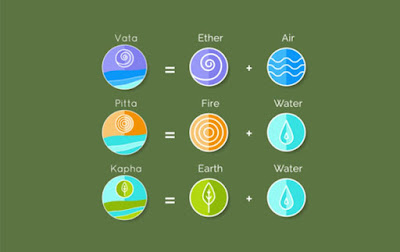Ayurveda And Your Life Energy
- How to Balance Your Doshas with Ayurveda?
Ayurveda is a way of life that is in harmony with nature. Ayurveda helps to know more about your Prakruti and constitution. Ayurveda, or life science, translated from Sanskrit, is an ancient science of health and healing. It believes that everything in the universe is made up of five noble elements (Panch Mahabutas)- Space (Akasha), Air (Vayu), Fire (Agni), Water (Jal), and Earth (Prithvi). This explains the necessity of maintaining these elements in balance for a healthy body and mind.
Every person is affected by relevant factors than others because of his or her natural constitution (Prakriti) and they are classified as three doshas:
Vata dosha - mainly comprises of air and space
Pitta dosha - includes fire elements
Kapha dosha - where the earth and water elements dominate
Mainly the illnesses are caused by the imbalances of these doshas. Ayurveda can definitely help you to be healthy by balancing these Doshas. Let us look at more information about Doshas and how this imbalance of Doshas affects our bodies.
👉Vata Imbalance
The Vata imbalance for a long can affect the other two doshas also so Vata dosha is the most important of all three doshas. Vata is the dosha that helps in the movement of the body. This feature makes Vata very essential, as it has been found that the other two Doshas are inactive without the ability to move. The key role of Vata is to maintain sensory and mental balance, as well as to enhance individuals' cognitive abilities and the way they perceive things.
Symptoms and Effects of Vata Imbalance
Symptoms
Physical symptoms: Constipation, gas formation or distension in the abdomen, dehydration, dry and rough skin. Pains and general body-ache, loss of strength, fatigue, lack of sleep, tremors and twitches, feeling dizzy, desire for warmth
Behavioral Symptoms: Confusion, fear, shaky, Irrational, Anxious, Nervous, Agitated, Impatient, feeling ungrounded, more walks and talks, and wanting to run away.
Effects
Headaches, Wasting of muscles, weight loss, constipation, cramps, dryness, tremors, retention, stiffness, joint pains.
👉Pitta imbalance
Ayurveda says that Pitta regulates heat, metabolism, and changes in the mind and body. In addition, it regulates how foods are digested, how sensory perceptions are metabolized, and how they distinguish between right and wrong. Pitta regulates the essential digestive “Agni” or fire of the body.
Symptoms and effects of pitta balance
Physical Symptoms: Hot flushes in body, burning sensation in eyes, hands, and sole, hot flushes in body, skin rashes, hypersensitivity to light, headache, bitterness in the mouth, vomiting bile, more thirst, and hunger.
Behavioral Symptoms:
Impatience, anger, judgmental, restlessness, irritating speech and actions
Effects:
Skin rashes, inflammations, hyperacidity, pimples, burning sensations
👉Kapha imbalance
Kapha is the heaviest of the three doshas. It gives structure and lubrication to the body. These properties help to balance the movement of Vata and the metabolism of Pitta.
Kapha works in a well-understood and comprehensive way for people with energy disposition. They may seem slow and difficult to other people, but they have extraordinary strength and power.
Symptoms and Effects of Kapha imbalance
Physical Symptoms:
Symptoms of cold, lethargy, difficulty in breathing, weight gain, lack of appetite, congestion, secretion in mouth, water retention
Behavioral Symptoms:
Depression, feeling of greed, feeling of lack of love, dullness
Effects:
Swellings, extra growth, excess mucus productions, obesity, depression
Realizing the harms and the consequences of dosha imbalances will help to find the cause of illness and seek help. If you notice any of the above symptoms and effects, consult an Ayurvedic doctor.
Dhathri Ayurveda Hospital and Panchakarma Center is one of the best Ayurveda hospitals in Kerala offering treatments for more than 25 health problems. The people who want to check their Vata, Pitta, and Kapha can directly visit our hospital or can consult our doctors through an online consultation portal.





Comments
Post a Comment